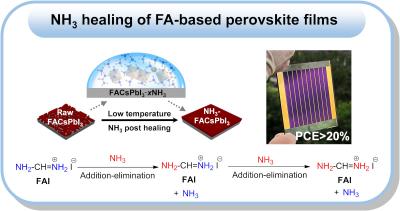Perovskite-Info weekly newsletter
Published: Tue, 08/16/22
The Perovskite-Info newsletter (August 16, 2022)
Cannot read this? View it online here
Researchers successfully tackle the stability issue of perovskite LEDs
Perovskite LEDs can be produced quite easily and at low cost.They show great promise as they are lightweight and can offer flexibility compared to OLEDs, with color purity and tunability similar to LEDs based on III-V semiconductors. However, the poor device stability of perovskite LEDs will have to be overcome before commercial applications can emerge. Typical lifespans of perovskite LEDs are on the order of 10 to 100 hours. In contrast, the minimum lifetime required for an OLED display is 10,000 hours. It is currently challenging to reach this threshold, as halide perovskite semiconductors can be intrinsically unstable due to the ionic nature of their crystal structures—the ions can move around when voltages are applied to the LEDs, leading to material degradation.
In their recent work, a research group led by Prof. Di Dawei and Prof. Zhao Baodan at the College of Optical Science and Engineering of Zhejiang University discovered that by using a dipolar molecular stabilizer, it is possible to make efficient and stable perovskite LEDs with ultralong lifetimes, satisfying the demands of commercial applications. The research was carried out in collaboration with the research groups of Prof. Li Cheng at Xiamen University, Prof. Hong Zijian at Zhejiang University, and Prof. Li Weiwei at NUAA and formerly at Cambridge University.
Researchers use perovskite superlattices with efficient carrier dynamics in novel PSCs
Scientists at the University of California San Diego, Lawrence Berkeley National Laboratory, Stanford University, Los Alamos National Laboratory, Korea's Yonsei University and Daegu Gyeongbuk Institute of Science and Technology have developed a novel perovskite solar cell, made of a lead-free low-dimensional perovskite material with a superlattice crystal structure. The material exhibits efficient carrier dynamics in three dimensions, and its device orientation can be perpendicular to the electrodes. Materials in this particular class of perovskites have so far only exhibited such dynamics in two dimensions—a perpendicularly orientated solar cell has never been reported.
The team reported that thanks to its specific structure, this new type of superlattice solar cell reaches an efficiency of 12.36%, which is the highest reported for lead-free low-dimensional perovskite solar cells (the previous record holder’s efficiency is 8.82%). The new solar cell also has an unusual open-circuit voltage of 0.967 V, which is higher than the theoretical limit of 0.802 V. Both results have been independently certified.
Researchers use ammonia for healing formamidinium-based perovskite films
Researchers from the Qingdao Institute of Bioenergy and Bioprocess Technology (QIBEBT) and Chinese Academy of Sciences (CAS) have developed a method for processing formamidinium-based perovskite films, using a unique ammonia treatment to remove pore structures formed during the processing.

Methods and solvents used in processing perovskite films have been extensively studied, but these still require additional processing steps or materials to make perovskite films work. For instance, the extremely promising methylamine gas healing method is only suitable for methylammonium-based perovskite, but is not feasible for the more efficient formamidinium-based perovskite. In order to find solutions to the gas healing of the formamidinium-based perovskite films, the researchers first studied the underlying reactions responsible for the challenges. “We have shown that the degradation of formamidinium-containing perovskites is caused by a reaction between the formamidinium cation and aliphatic amines, producing ammonia,” said WANG Xiao from CAS, the second author of the study.
Evolar's perovskite solar cell technology meets demands of 25 years stable lifespan
Sweden-based Evolar, which has developed a unique perovskite-based solar cell technology, has announced that it can now present results from climate tests that show at least 25 years lifespan with stable electricity yield.
Evolar's tandem technology reportedly provides 25% more electricity at a low cost. However, to be commercially ready, solar panels also need to have a guaranteed lifespan of at least 25 years with stable electricity generation throughout this period.
TubeSolar raises USD$4.8 million
German photovoltaic (PV) thin-film tubes developer TubeSolar recently raised EUR 4.68 million (around USD$4.8 million).TubeSolar said previously that it intends to use the proceeds to support its growth and for investments in the development of the highly-automated production of its PV modules.
Researchers combine experiments and models to improve the efficiency of perovskite solar cells
Researchers from the University of Pennsylvania’s Andrew M. Rappe's group and Princeton University's Yueh-Lin Loo's group recently examined how the molecular make up of certain perovskites might affect their efficiency and offered a path forward to better solar cells using a simple metric.
“The world currently needs more efficient and cost-effective photovoltaic cells, and 3D hybrid perovskite PVs have taken the world by storm,” says Rappe, a professor in Penn’s Department of Chemistry who also co-directs Penn’s VIPER program. “But they are irreversibly damaged by water, which is a showstopper for practical applications. Inserting organic molecular planes between 2D hybrid perovskite planes is a promising scheme to provide efficient, low-cost, and robust solar cells.”
Halide perovskites enable novel photo-rechargeable supercapacitors
Researchers from the Indian Institute of Technology Roorkee and the University of Massachusetts Amherst have developed perovskite-based photo-rechargeable supercapacitors.
The team explained in the study that current approaches for off-grid power separate the processes for energy conversion from energy storage. However, with the right balance between the electronic and ionic conductivity and a semiconductor that can absorb light in the solar spectrum, it is possible to combine energy harvesting with storage into a single photoelectrochemical energy storage device. In their new work, the researchers reported such a device - a halide perovskite-based photorechargeable supercapacitor that simultaneously harvests and stores energy.
Metalgrass LTD
9 Har Tsin St.
Kfar Sava Hasharon 4430809
ISRAEL
Unsubscribe | Change Subscriber Options




